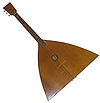- Chokha
-
A chokha (Georgian: ჩოხა,ტალავარი; Chechen: coqib; Azerbaijani: çerkezi çuxa[1]; Russian: Черкеска, cherkeska, Ossetic: цухъхъа, cuqqa) is part of the traditional male dress of the peoples of the Caucasus. It has been in wide use among Georgians from the 9th century until 1920s[2] and among Azeris between the 17th and the 20th century.
Also, "Chokha" in a Indian Language, Tamil, is still in use for referring to their traditional dress. The British hard-rock legend Ian Gillan and his wife Bron, dressed in Georgian national costumes, in Tbilisi during Gillan's 1990 visit to the Soviet Union.
The British hard-rock legend Ian Gillan and his wife Bron, dressed in Georgian national costumes, in Tbilisi during Gillan's 1990 visit to the Soviet Union.
- There are Four types of Chokha: Kartl-Kakheti chokha (Kartli and Kakheti are eastern Georgian provinces), Khevsur Chokha (mainly in Mtskheta-mtianeti province of Georgia), Adjarian chokha (mainly found in western Georgia provinces such as Adjara and Guria and also used to be used in Lazona that is now part of republic of Turkey, it is shown in fourth picture on this page) and General Caucasian chokha which most likely to Kartl-Kakheti chokha and is little longer version of it. Caucasian Chokha originated in Caucasus[3] most likely from its mountainous sites, Chokha isn't in Georgian language but from Turkic. Originally the cloth in Georgia was referred as Talavari but later on after Persian invaisions in Georgia, Persians called Georgian national dress Chokha (meaning fabricly made outfit). The name of the cloth moslty known as "chokha", the Russians who came to the Caucasus through Circassia called it "Cherkeska" (meaning Circassian dress), and the Cossacks adopted it as their national cloth. In Circassian Language Chokha is known as "Shwakh-Tsia"" which means "covers the horseman" or simply "Tsia" which means "from fabric" and "Fasha" which means "Fits you". The authentic Caucasian Chokha became instantly popular in entire Caucasus, it derived form caucasus and has been commonly used in northern and eastern slopes of it[3]. In earlier Georgian records Chokha was mostly referred as Talavari
- Circassian authentic outfit is shown in third photo on this page .
In Georgia, the Black chokha was reserved to the "Orden of Chokhosani" who represented the elite society of the citizens. These were people with special dedications such as: Great generals, heroes or some of the famous poets and the people who had done some big service to the country. Not even all of Lords were allowed in "Chokhosani Orden" and those who did proudly represented this rank in their Gerbs. chokha is sewn of thick fabric and is tight on the waist and wide on the bottom. In some parts of the Caucasus there are also female chokhas.
In the late 19th century and early 20th century there were three types of chokhas: the Khevsur chokha, the Kartl-Kakheti chokha and general Caucasian chokha.
Contents
Khevsur chokha
The Khevsur chokha was worn in the Khevsureti province of Georgia in the Greater Caucasus mountains. Khevsur chokha is considered to be the closest to the medieval version of chokha. It is mostly short with trapezoid shapes. The front side of the chokha has rich decorations and cuts on the sides, which extend to the waist. The Khevsur chokha has rich decorations made up of crosses and icons.
Kartl-Kakheti chokha
The Kartl-Kakheti chokha is longer than the Khevsur chokha and has triangle-like shapes on the chest exposing the inner cloth called arkhalukhi. The bottom sides usually had cuts on the sides and people wore it usually without belts. The Kartli-Kakheti chokha has long sleeves and mostly is black, dark red and blue.
General Caucasian chokha
 Baron Pyotr Nikolayevich Wrangel wearing a cherkeska at a prayer vigil along with some others in the background.
Baron Pyotr Nikolayevich Wrangel wearing a cherkeska at a prayer vigil along with some others in the background.
The general Caucasian chokha shares similarities with the Kartl-Kakheti version, with the exception of having bandoliers sewn horizontally across both sides of the chest. In most cases different decorations are used to fill the bullet spaces. In the Russian language, chokha is called cherkeska and this type of chokha has black leather belts decorated with silver pieces.
The general Caucasian chokha is mostly made of black, grey, white, blue, red or brown fabric. Among Azeris, it is considered part of the traditional outfit for the performers of mugham, an Azeri folk music genre. A person's age defined the colour of the chokha he would wear.
Generally, the chokha outfit includes a khanjali (the sword), the akhalukhi (a shirt worn underneath the chokha), the masrebi (the bullets), and the kabalakhi (a hood, separate from the robe) or nabdis kudi (a tall fur hat).
Notes
References
- Abashidze, Irakli. Ed. Georgian Encyclopedia. Vol. IX. Tbilisi, Georgia: 1985.
External links
- Ruso Strelkova (August 31, 2007). To Wear or not to Wear (a Chokha)? That is the Question. Georgia Today Issue #372, 31.08.07-06.09.07.
Russian souvenirs, arts and crafts 

Handicrafts Gorodets painting · Gzhel · Kholmogory bone carving · Khokhloma · Russian lacquer art ( Fedoskino miniature · Kholuy miniature · Mstyora miniature · Palekh miniature) · Russian icons · Zhostovo painting


Tableware Table-glass · Podstakannik · Russian porcelain ( Dulyovo porcelain ) · Samovar
Clothing Budenovka · Cherkeska · Gymnasterka · Kokoshnik · Kosovorotka · Lapti · Orenburg shawl · Papakhi · Peaked cap · Sailor cap · Sarafan · Telnyashka · Ushanka · Valenki
Musical
instrumentsBalalaika · Garmon · Russian guitar · Musical spoons · Treshchotka
Toys Bird of Happiness · Cheburashka · Dymkovo toys · Kargopol toys · Matryoshka doll · Petrushka
Other Fabergé egg · Shashka · Tula gingerbread · Vodka
Categories:- Clothing of Georgia (country)
- Azerbaijani clothing
Wikimedia Foundation. 2010.

